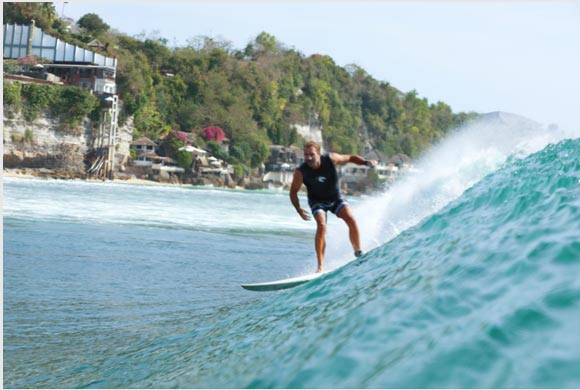SURF FITNESS: BEST STRENGTH EXERCISES

The Best Strength Exercises to Improve Your Surfing
Last week we focussed on cross training exercises to get your surf fitness up. Today we focus on the best strength exercises for surf fitness
Surfing is not like most sports: there’s no running clock, there’s no designated playing area, and there is certainly no prescribed training regime that works for all athletes. Many would argue that surfing is not a sport, but rather a lifestyle.
Hanging out at the beach and catching waves certainly doesn’t feel like a sport. Regardless of one’s views on where surfing fits into the sporting world, no one can deny that surfing is physically demanding. Simply paddling out on a decent-sized day requires a well-tested cardiovascular engine and a fit upper body. Catching a wave and popping up entails heightened agility and ample flexibility.
While the act of actually riding a wave and carving demands intense core strength and sturdy legs. Not all surfers are the type to hit the gym and pump serious iron, and that’s ok. Bulky muscle is not conducive to paddling, anyways. To achieve an optimal level of surf fitness, one needs the perfect blend of strength and muscle endurance. Dive in below, to check out Swell’s:
BEST SURF FITNESS EXERCISES
1. Pushups
 This may seem obvious, but the simple push-up is a highly effective, yet often overlooked, tool for building upper body strength and endurance. The good thing about the push-up, as with any bodyweight exercise, you won’t build bulky, excess mass.
This may seem obvious, but the simple push-up is a highly effective, yet often overlooked, tool for building upper body strength and endurance. The good thing about the push-up, as with any bodyweight exercise, you won’t build bulky, excess mass.
Instead, you will build functional upper body strength that is proportionate to your body weight. Work to perform a high number of reps at a high intensity. Set a lofty goal, like 100, 200, or 300 push-ups, and see how long it takes you to get there. Like paddling, the pushup, or press up as it is often referred to across the pond, requires a blend of strength and muscle endurance.
2. Pull-ups
 Like the pushup, the pull-up is another phenomenal bodyweight exercise that will build functional strength relative to one’s body weight, not bulky, unnecessary mass, so an ideal surf fitness exercise. Similarly to how we described the pushup, with the pullup we want to build our rep capacity.
Like the pushup, the pull-up is another phenomenal bodyweight exercise that will build functional strength relative to one’s body weight, not bulky, unnecessary mass, so an ideal surf fitness exercise. Similarly to how we described the pushup, with the pullup we want to build our rep capacity.
Start with a reasonable number like 10, 20, 30, 40, or 50 and attempt to execute that many reps in as few sets as possible. As you get stronger, set your rep goals higher. Unlike the pushup, the pull-up does, somewhat, mimic paddle movement and work the large muscles in the back (the lats) that are activated during paddling.
3. Inverted Rows
 Often used as a scaled-down pull-up substitute, inverted rows are a great way to strengthen your lats, the small muscles in your upper back, and your rear deltoids (all paddle muscles). As stated previously, if you cannot do a pull-up, inverted rows are a great place to start. To perform lay horizontally below a suspension trainer or secured barbell. The higher off the ground the suspension trainer/barbell, the easier the exercise will be.
Often used as a scaled-down pull-up substitute, inverted rows are a great way to strengthen your lats, the small muscles in your upper back, and your rear deltoids (all paddle muscles). As stated previously, if you cannot do a pull-up, inverted rows are a great place to start. To perform lay horizontally below a suspension trainer or secured barbell. The higher off the ground the suspension trainer/barbell, the easier the exercise will be.
With your heels planted on the ground, grip the bar slightly wider than shoulder-width apart, or hold your suspension trainer in a neutral position slightly wider than shoulder width. Pull your chest towards the bar/ suspension trainer. As you pull, keep your core tight and hips up, in line with the rest of your body. As your chest moves higher, pinch your shoulder blades together to activate the smaller muscles in your back. Perform three sets of ten.
4. Handstand Push Up
 Handstand push-ups might sound intimidating, but they are not as difficult as they may look and they have a myriad of benefits that will directly improve your surfing. Handstand pushups target your deltoids, which are used heavily when we paddle. What makes Handstand pushups superior to any old overhead press, for surf training specifically, is that like the aforementioned push-up and pull up, handstand pushups build lean muscle and functional strength relative to one’s body weight.
Handstand push-ups might sound intimidating, but they are not as difficult as they may look and they have a myriad of benefits that will directly improve your surfing. Handstand pushups target your deltoids, which are used heavily when we paddle. What makes Handstand pushups superior to any old overhead press, for surf training specifically, is that like the aforementioned push-up and pull up, handstand pushups build lean muscle and functional strength relative to one’s body weight.
To perform, place a pad about 12 inches from the wall.
Place your hands slightly wider than shoulder width on the sides of the pad and kick your feet up so that you are in a full handstand position with your heels supported by the wall. Lower your head slowly down until it is resting on the pad and then push up to the starting position. Perform 3 sets of 5-10 reps.
Here is a good article on how to get started with handstand push ups (opens a new window)
5. Pike Push Up
 For those not quite ready to kick up onto a wall and crank out handstand pushups, the pike push-up is the ideal substitute.
For those not quite ready to kick up onto a wall and crank out handstand pushups, the pike push-up is the ideal substitute.
Like the handstand push-up, the pike push-up targets our shoulder muscles (deltoids), which are crucial in paddling. To perform a pike push-up, place your feet on a bench or box, with your hands on the ground, wider than shoulder width, shape your body like an inverted L. With your torso vertical, and your legs horizontal, lower your head down to the floor between your hands, and press back up.
6. Suspension Trainer Rear Delt Fly
 The small muscles in our back our crucial for paddle endurance, but they are often overlooked in training. Fortunately, it doesn’t take much to keep your rhomboids and surrounding muscles fit. You don’t need to use a lot of weight, in fact, you only need to use a fraction of your body weight. Suspension trainer rear delt flies are a great way to train these muscles and you can do it virtually anywhere.
The small muscles in our back our crucial for paddle endurance, but they are often overlooked in training. Fortunately, it doesn’t take much to keep your rhomboids and surrounding muscles fit. You don’t need to use a lot of weight, in fact, you only need to use a fraction of your body weight. Suspension trainer rear delt flies are a great way to train these muscles and you can do it virtually anywhere.
To perform, grab the suspension trainer handles and hold them together vertically, at arm’s length away from your chest. Walk forward a few steps and lean back so that your body is hanging at a slight incline, supported by the suspension trainer. Firmly gripping each handle, with your elbows slightly bent, pull the handles apart, while simultaneously pinching your shoulder blades together. Perform 3 sets of ten, focusing on control and maintaining a slow movement throughout the set.
7. Burpee Box Jumps
 If you’re looking for an intense way to train explosiveness, like that required in a pop-up during a steep drop, look no further than the burpee box jump. Yes, it is as brutal as it sounds, but the combination of these two already explosive exercises create the perfect pop-up trainer. The burpee portion mimics the pop-up movement, training muscle memory, while the box jump adds lower-body strength training and explosiveness to the equation.
If you’re looking for an intense way to train explosiveness, like that required in a pop-up during a steep drop, look no further than the burpee box jump. Yes, it is as brutal as it sounds, but the combination of these two already explosive exercises create the perfect pop-up trainer. The burpee portion mimics the pop-up movement, training muscle memory, while the box jump adds lower-body strength training and explosiveness to the equation.
To perform, stand in front of a box slightly further than an arm’s length away. Drop to the ground, chest to the floor with your arms tucked at your side like you are about to perform a push-up. Then, explode off the floor back into a standing position and in one movement, execute the box jump.
8. Bosu Ball Stability Squats
 This exercise is a tad more advanced than some of the others, but if executed properly and regularly, it will enhance your surfing ability. The Bosu Ball is a unique piece of fitness equipment that allows you to train strength and balance simultaneously.
This exercise is a tad more advanced than some of the others, but if executed properly and regularly, it will enhance your surfing ability. The Bosu Ball is a unique piece of fitness equipment that allows you to train strength and balance simultaneously.
If you can already properly execute a squat while balancing on a Bosu Ball, consider adding weight. If you’ve already added weight, try adding uneven loads, like one kettlebell overhead, and alternate sides. To perform, place the Bosu Ball ball side down and stand on the platform with your feet shoulder distance apart. Slowly and carefully, lower yourself down into a squat position. Make sure your knees never go past your heels. Add weight if necessary.
9. Rowing
 The erg machine might be the best piece of equipment in the gym for total body surf training. Rowing recruits massive amounts of lower body strength, arm and back strength, muscle endurance, and heavy aerobic activity. Whether you’re training to paddle hard, toss buckets on turns, or to last hours in the lineup rowing is the exercise for you. To start, try rowing 1000 meters for time.
The erg machine might be the best piece of equipment in the gym for total body surf training. Rowing recruits massive amounts of lower body strength, arm and back strength, muscle endurance, and heavy aerobic activity. Whether you’re training to paddle hard, toss buckets on turns, or to last hours in the lineup rowing is the exercise for you. To start, try rowing 1000 meters for time.
The most important part of training and getting in shape, is finding something that works well for you and that will keep you motivated. If you can surf every day, do it. There is no better surf training than surfing itself. If you can’t surf every day, hit the gym, the pool, the yoga studio, or the trail.
Enhancing Flexibility with Yoga
Best Yoga Poses for Surfers
Yoga and surfing go together like peanut butter and jelly. Yoga helps you become more flexible and balanced, which is super important for surfing. Some great yoga poses for surfers include:
- Downward Dog
- Warrior II
- Pigeon Pose
- Cobra Pose
- Child’s Pose
These poses help stretch and strengthen your muscles, making it easier to move on your board.

How Yoga Prevents Injuries
Doing yoga regularly can help you avoid getting hurt while surfing. Yoga improves your posture and makes your joints healthier. This means you’re less likely to pull a muscle or strain something. Plus, yoga helps you stay relaxed and focused, which is key when you’re out on the waves.
Incorporating Yoga into Your Routine
Adding yoga to your daily routine is easier than you think. Start with just 10 minutes a day. You can do it in the morning to wake up your body or in the evening to wind down. Try to mix it up with different poses to keep things interesting. And remember, the more you practice, the better you’ll get at surfing!
Improving Balance with Bosu Ball Exercises
Top Bosu Ball Moves
The Bosu Ball is a fantastic tool for improving your balance and strength at the same time. Here are some top moves to try:
- Bosu Ball Squats: Stand on the flat side of the Bosu Ball and perform squats. This will challenge your stability and leg strength.
- Single-Leg Balance: Stand on one leg on the Bosu Ball and try to hold your balance. Switch legs after a set time.
- Push-Ups: Place your hands on the Bosu Ball and do push-ups. This adds an extra balance challenge to a classic exercise.
Benefits for Surfing
Using a Bosu Ball can greatly improve your surfing skills. Better balance means better control on your board. Plus, the strength you build will help you paddle stronger and pop up faster.
Safety Tips
When using a Bosu Ball, safety is key. Here are some tips to keep in mind:
- Start slow: Begin with basic exercises and gradually move to more advanced ones.
- Use a spotter: If you’re trying a new move, have someone nearby to help if needed.
- Keep your core engaged: This helps maintain balance and prevents falls.
- Check your form: Make sure you’re doing the exercises correctly to avoid injury.
Cardio Boost: Jump Rope Drills
Why Jump Rope is Great for Surfers
Jump rope is an awesome way to boost your cardio and get your heart pumping. It’s a full-body workout that helps improve your coordination, balance, and endurance. Plus, it’s super fun and can be done almost anywhere!
Fun Jump Rope Routines
Mixing up your jump rope routines can keep things exciting. Here are a few to try:
- Basic Jump: Just your standard jump, but try to keep a steady rhythm.
- High Knees: Bring your knees up to your chest with each jump.
- Double Unders: Swing the rope under your feet twice for every jump.
- Criss-Cross: Cross your arms in front of you while jumping.
Jump Rope Safety Tips
To avoid injuries, keep these tips in mind:
- Warm-Up: Always start with a warm-up to get your muscles ready.
- Proper Footwear: Wear supportive shoes to protect your feet and ankles.
- Smooth Surface: Jump on a flat, non-slip surface to prevent falls.
- Stay Hydrated: Drink plenty of water before, during, and after your workout.

Conclusion
Surfing is more than just a sport; it’s a way of life that demands a unique blend of strength, flexibility, and endurance. By incorporating these strength exercises into your routine, you’ll not only improve your surfing skills but also reduce the risk of injury. Remember, the key is consistency and having fun with your workouts. So, grab your board, hit the gym, and get ready to ride those waves with more power and confidence. Happy surfing!
Frequently Asked Questions
Why are push-ups important for surfers?
Push-ups help build upper body strength, which is essential for paddling and popping up on your board.
How do planks improve my surfing skills?
Planks strengthen your core, which helps with balance and stability while surfing.
What benefits do squats offer to surfers?
Squats build leg strength, which is crucial for maintaining balance and control on your surfboard.
Why should surfers include rows in their workouts?
Rows strengthen your back muscles, which are important for paddling and overall posture.
Are burpees good for surfing endurance?
Yes, burpees are great for building both cardio and strength, helping you last longer in the water.
How can lunges help my surfing performance?
Lunges improve lower body strength and stability, which are key for powerful and controlled movements on your board.
What yoga poses are best for surfers?
Poses like Downward Dog, Warrior, and Pigeon help improve flexibility and prevent injuries.
Why is balance training important for surfers?
Balance exercises, like those on a Bosu ball, help you stay steady on your board and react quickly to waves.
This article: Surf fitness exercises is part of our Swell instructional how to surf blog posts. Other popular episodes are:
- HOW TO PADDLE ON A SURFBOARD
- SURF TECHNIQUE: HOW TO DUCK DIVE
- SURF ETIQUETTE: THE GOLDEN RULES
- SURF EQUIPMENT CHOOSING THE RIGHT SURFBOARD
- SURF TECHNIQUE: 1. THE POP UP
- THE BEST YOGA POSES FOR SURFING
- 7 CROSS TRAINING TIPS FOR PEAK SURFING PERFORMANCE
About us
Have a look and see what a surf holiday with Swell is all about. We offer learn how to surf holidays for adults looking for an active & social water sport holiday. But we also offer a stylish and comfortable place to stay for people who already know how to surf.
-
WHERE IS SWELL LOCATED?
Swell Surf camp is located on the North coast of the Dominican Republic, right in the center of the cool surfer town of Cabarete. With 3 international airports to choose from it's also one of the easiest places to get to for a quick surf getaway. Puerto Plata Airport is only 25 minutes away from Swell. On the' getting here' page you'll find the different options of getting to us.
-
ABOUT SWELL SURF CAMP
Founded in the winter of 2009, Swell Surf Camp emerged from Jeroen and Clare Mutsaars vision. They lived in the Dominican Republic for eight years and spotted a gap in the surf camp market for higher quality accommodations combined with an engaging social atmosphere. Their extensive travel and stay experiences across different countries like Costa Rica, Nicaragua, Peru, Hawaii, Indonesia and various European nations fueled their passion to elevate the surfing retreat experience.
Swell Surf Camp is renowned as the world’s first luxury surf camp tailored specifically for beginners. The founders collaborated with a notable Swiss architect to design facilities that blend comfort with style. This innovative approach ensures every guest enjoys superior lodging and amenities. Since its inception, Swell has taught over 9,000 people how to surf with an emphasis on safety, fun, and structure.
Our achievements speak volumes. Swell has collected numerous accolades and maintains hundreds of stellar reviews from guests globally. Recognized repeatedly as the leading destination for luxury surf vacations, our commitment to excellence keeps us at the forefront of the industry.
Beyond surfing, Swell offers a diverse range of activities including kitesurfing, wingfoiling, and yoga classes. Guests can also enjoy horse riding both on scenic beaches and mountain trails—plus exciting adventure-filled excursions like canyoning.
A crucial element of any vacation is food, and here at Swell we excel. We provide delicious home-cooked meals daily. For evenings out, guests find themselves just minutes away from an array of dining options that promise satisfying culinary adventures.
For those who prioritize upscale amenities and wellness in a unique setting built around learning surf skills amid profound natural beauty, Swell should be on the top of your surf destination list
-
WHAT TO EXPECT FROM A 1 WEEK LEARN TO SURF HOLIDAY
Dreaming of catching your first wave but wondering if surf lessons are really for you? At Swell Surf Camp, our lessons are designed specifically for beginners, and we mean absolute beginners, particularly those between 40 and 55 from cities like New York, Boston, or Toronto. You’ll never feel rushed, lost, or out of place. Our expert instructors genuinely love teaching, and their approach is as much about encouragement as it is about skill-building. Every instructor carefully tunes each lesson to fit one person, you, so you always get personalized support, whether you’re working on basic paddling, learning to pop up, or building confidence in the water.
The journey at Swell Surf Camp is about progression, not perfection. You’ll start with the very basics, practicing on the sand before moving into gentle ocean waves with your instructor right beside you. Throughout every lesson, our focus is on clear communication, safety, and keeping things fun. As you progress, our instructors give you feedback in real-time, helping you celebrate small wins and guiding your next steps. You’ll learn solid surfing foundations, water safety, and even the unwritten rules of surf culture. By the end of your stay, you’ll be amazed at your own growth and how natural surfing feels. Don’t wait to discover how transformative a single lesson can be, book your surf adventure at Swell Surf Camp and let your surfing journey begin!
-
WHAT SPORTS DOES SWELL OFFER?
It's not only surfing that's on offer at Swell, we also offer learn to wingfoil and learn to kitesurf packages.





